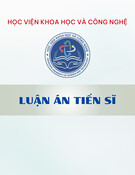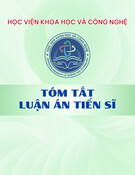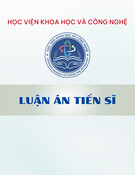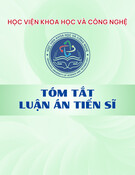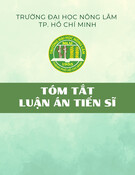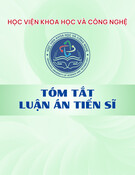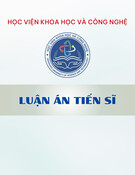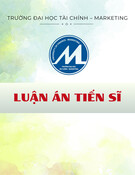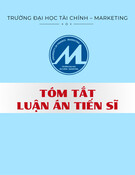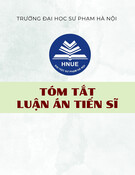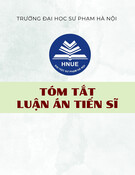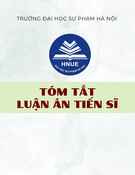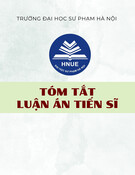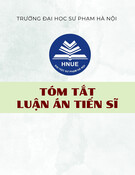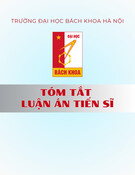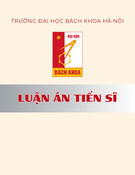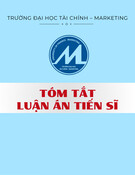
MINISTRY OF
EDUCATION AND
TRAINING
VIETNAM ACADEMY
OF SCIENCE AND
TECHNOLOGY
GRADUATE UNIVERSITY SCIENCE AND TECHNOLOGY
----------------------------
PHAM DINH DUNG
Study to produce oligochitosan-silica nano and investigate
the induced systemic resistance against anthracnose
disease caused by Colletotrichum spp. on hot chilli
(Capsicum frutescens L.)
Major: Biotechnology
Code: 9 42 02 01
SUMMARY OF BIOTECHNOLOGY DOCTORAL THESIS
Ho Chi Minh City – 2020

The thesis was completed at: Graduate University of Science
and Technology - Vietnam Academy of Science and
Technology
Supervisor 1: Assoc. Prof., Dr. NGUYEN TIEN THANG
Supervisor 2: Assoc. Prof., Dr. BUI VAN LE
Reviewer 1:
Reviewer 2:
Reviewer 3:
The thesis shall be defended in front of the Thesis Committee
at Academy Level at Graduate University of Science and
Technology - Vietnam Academy of Science and Technology
At...... hour....... date...... month...... year 20..
The thesis can be found at:
- The National Library
- The Library of Graduate University of Science and
Technology

1
INTRODUCTION
1. The necessity of the thesis
Hot chili (Capsicum sp.) is a spice plant grown in the
tropics and consumed around the world due to its high
economic value. However, diseases caused by fungi, viruses
and bacteria are the major constraints to hot chili production.
Among the diseases on hot chilli, pathogenic fungus is one of
the main reasons cause of loss 10-80% hot chilli production in
Vietnam, India, Thailand, Korea… Common diseases on hot
chili are caused by Rhizoctonia solani, Colletotrichum spp.,
Botrytis cinerea, Fusarium oxysporum, Phythopthora
capsica,…, anthracnose disease, caused by Colletotrichum spp.
is one the most destructive diseases restricting hot chili
production. Colletotrichum spp. mainly causes anthracnose
disease in hot chili. This fungus damages on branches, leaves,
flowers and fruits. The symptoms of anthracnose are circular or
angular sunken lesions on hot chili fruits and shaped brown
spots with dark brown edges on leaves, with concentric rings of
acervuli. When symptoms are more serious, hot chili fruits
become shrinkage and inedible or drop, which can cause 70-
80% yield loss.
Nowadays, many kinds of fungicides are used to
control pathogenic fungi in plants. However, the utilization of
high concentration of fungicide disrupts the balance of useful
microorganisms in soil. This condition can become good
environment for the growth of pathogens and existence of
chemical resistant insect pests. The fungicidal residues in
agricultural products and soil cause the groundwater pollution,
environmental pollution, especially health hazard of human and
animals. To prevent intentionally using of fungicides, disease
tolerant plants are grown but the result is not effective. These
strains are low productivity and instability. Moreover, plant
elicitors, used as biological solutions, activate the disease
resistance mechanism in plants. This solution is becoming a
trend in sustainable and green agriculture development. With

2
the aim of reducing the use of toxic chemicals and genetically
modified plants. Chitin and silicon are two common ingredients
in nature. Many studies reported that chitosan, oligochitosan
(chitin derivatives), along with silicon and nano silica have
biological activities such as antimicrobial, antifungal and
increasing disease resistance ability in most of plants, they help
plant to secrete enzymes, bioagents for pathogenic prevention,
and promote the plant growth and development.
Based on the above mentions, “Study to produce
oligochitosan-silica nano and investigate the induced systemic
resistance against anthracnose disease caused by Colletotrichum
spp. on hot chilli (Capsicum frutescens L.)” was carried out.
2. The objectives of the thesis
- Identify the pathogenicity potential and classificate at
species level of Colletotrichum spp. isolated from hot chilli in
Vietnam.
- Produce stable oligochitosan-silica nano, which
potentially highly induced effectively the systemic resistance
against anthranose disease on hot chilli, based on the
combination of low molecular weight chitosan with nano silica.
- Detect the potential control the anthracnose disease
caused by C. gloeosporioides and C. truncatum on hot chilli in
vitro, greenhouse and opened-field conditions of oligochitosan-
silica nano created.
3. The main contents of the thesis
- Content 1: Isolation, investigation of pathogenicity
and morphological and molecular identification of
Colletotrichum spp. causing anthracnose disease in hot chilli
- Content 2: Improving technology for making
oligochitosan-silica nano (SiO2)
- Content 3: Evaluation of the ability of oligochitosan-
silica nano stimulating resistance against C. gloeosporioides
and C. truncatum causing anthracnose disease in hot chili in in
vitro condition
- Content 4: Evaluation of the ability of oligochitosan-
silica nano stimulating resistance against C. gloeosporioides

3
and C. truncatum causing anthracnose disease in hot chili in
greenhouse and field conditions.
Chapter 1. LITERATURE REVIEW
1.1. Introduction of hot chili (Capsicum sp.)
Hot chili (Capsicum sp.) belongs to the family Solanaceae,
originating from the Americas. Hot chili plants usually grow in
clump, 60-80 cm or 1 m high, having many branches and
smooth body; the leaves alternate, oblong shaped, apex pointed.
The flowers grow alone in the leaves. Peppers are easy to grow
and suitable for many kinds of soil and ecological areas. Hot
chili peel contains alkaloid-capsaicin. Hot chili grows in warm
condition and high humidity but dry condition for maturation.
The suitable temperature for growth and development of hot
chili is 18-30oC. Hot chili can not grow well in high
temperature- above 32oC or low temperature- below 15oC
(Tripodi and Kumar 2019). Hot chili genus has about 25-30
species, 5 species (Capsicum frutescens L., C. annuum L., C.
chinense Jacq, C. pubescens Keep and C. baccatum L.) have
been domesticated and cultivated (figure. Nowadays, C.
frutescens is the most popular strain, then C. annuum L.(Jaret et
al 2019).
1.2. Introduction of Colletotrichum spp. and anthracnose
disease of chilli
1.2.1. Introduction of Colletotrichum spp.
Colletotrichum species belong to Kingdom-Fungi, Division
- Ascomycota, Class-Sordarriomycetes, Order-Phyllachorales,
Family-Phyllachoraceae. Disease caused by Colletotrichum spp.
very popular on plants (ornamental plants, leafy plants and
fruity trees). According to the ranking of Molecular Plant
Pathology Journal (2012), Colletotrichum spp. was ranked No.
8 among the top 10 pathogenic fungi and caused anthracnose,
which seriously affects growth, development and productivity
on many valuable crops such as citrus, hot chili (Capsicum sp.),




